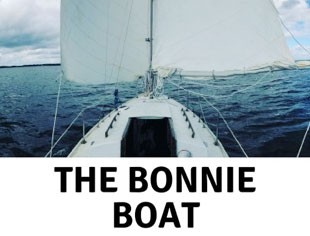This is an adapted (slightly edited) transcript from our interview with Chris Smith of the Bonnie Boat Podcast… in case you prefer to read your podcasts! If this is the first time you’ve heard of this excellent podcast and you want to listen to it, you can do that right here.
CHRIS:
Alrighty folks, welcome to this episode of the Bonnie Boat Sailing Podcast. My name is Chris Smith. Today I have for you a chat I had with Ben and Teresa Carey of Morse Alpha Expeditions among many of their projects. I would be surprised if many of you listening weren’t already familiar with their work, but in case you haven’t been paying attention, Teresa has written for many of the major sailing publications. She has the blog, Sailing Simplicity. She and Ben met while they were both single-handing their respective boats. They then went on to make a full-length documentary film called One Simple Question about their trip sailing the way up North to find a record breaking iceberg. A few years later, they started Morse Alpha, which is a sail training program that teaches seamanship navigation and coastal and offshore sailing. Additionally, they’re now working on a podcast called All Hands, which will be releasing a new episodes shortly. You can find more about there are many projects at morselpha.com and sailingsimplicity.com. So without further preamble on my part, I give you Teresa and Ben Carey.
CHRIS:
I thought we’d start by talking about Morse Alpha. What was the genesis and what are your goals when you take people out sailing?
TERESA:
Morse Alpha has really been a long evolution because Benji and I both started as sail trainers on other boats and we’ve worked for a lot of educational programs. So it was a natural flow for us. When we decided to downsize from two boats—we each had our own boat—we started looking at the boats that would be right for us. We thought eventually in that search process, which took us over a year, we eventually decided, well, let’s get a bigger boat and do sail training expeditions on board. Because during that year while we were looking for our boat, we were being hired by people who had just bought a boat and they wanted to learn to sail their new boat. So they’d hire us for a couple of weeks to come aboard, help them move their boat to their new home and teach them to sail it. And we realized that we really enjoyed that work and we could make a business out of this, on our own boat. And that’s how Morse Alpha has started.
CHRIS:
So what kind of people are coming sailing with you? Is it usually folks who have purchased a boat and are looking to up their experience? Is that people who are new to sailing.
TERESA:
It’s both. We have some people that have quite a bit of sailing experience and then some people that have none at all. Some of them own boats and some of them are planning to buy a boat or anything in between. It’s all types of people really.
CHRIS:
You mentioned that you had both started out in sail training, but in different circumstances. And, as I recall, I think you worked on tall ships. Is that right? What was that like?
BEN:
I did a bunch of tall ships Schooners and square-riggers during my twenties and early thirties. I loved it. It’s a lot of hard work. I did a bunch of different kind of “schooning”. Some just sailed during the day, some did offshore passages. Each one was a little different and had a different program. But, I loved them all. Most of them were sail training, so we were teaching high school or college students, sailing and offshore sailing, navigation, seamanship and all that. And then some of them were passengers who were sitting reading books and enjoying the day. Those boats were all wood and they all had huge sails and they all were human-powered. Nothing was electric or anything like that. So it gives you a good appreciation for the forces that go into sailing, and it keeps you fit.
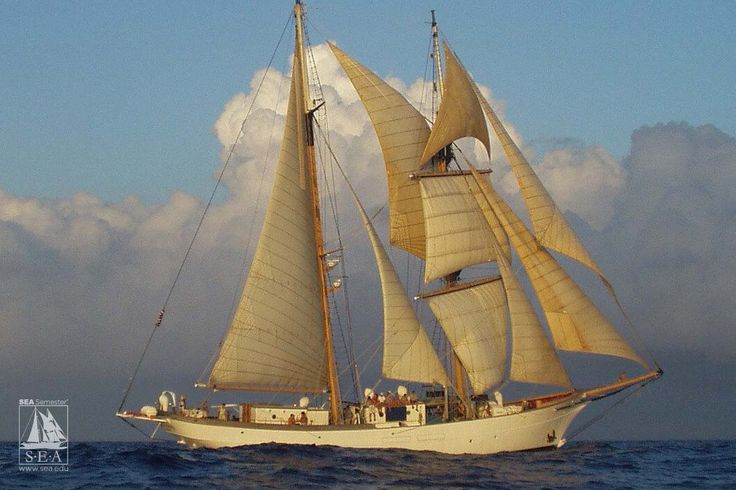
TERESA:
I’ve done some work on schooners, but I would say that the bulk of my sail training career was with the Outward Bound sea program in both Maine and the Pacific Northwest, aboard little rowing and sailing boats. Well, they’re not little, they’re 30 feet, but they’re open boats. There’s no cabin. We would have 10 students and two instructors living and traveling and sleeping on this, basically, giant rowboat. They were modeled after the Coast Guard rescue boats, or captain Vancouver’s boats in the Pacific Northwest. Captain Vancouver’s lifeboats were the ones they used to explore the islands, and get into little nooks and crannies where they couldn’t bring their schooners. It’s a really, really rugged experience. Imagine not having a cabin and being in a 30 foot boat with 12 people and no privacy. You lay the oars across the boat and you sleep like sardines on the oars. We had no electronics, no engine. It was just sailing and navigating in the purest sense. And it was pretty amazing.
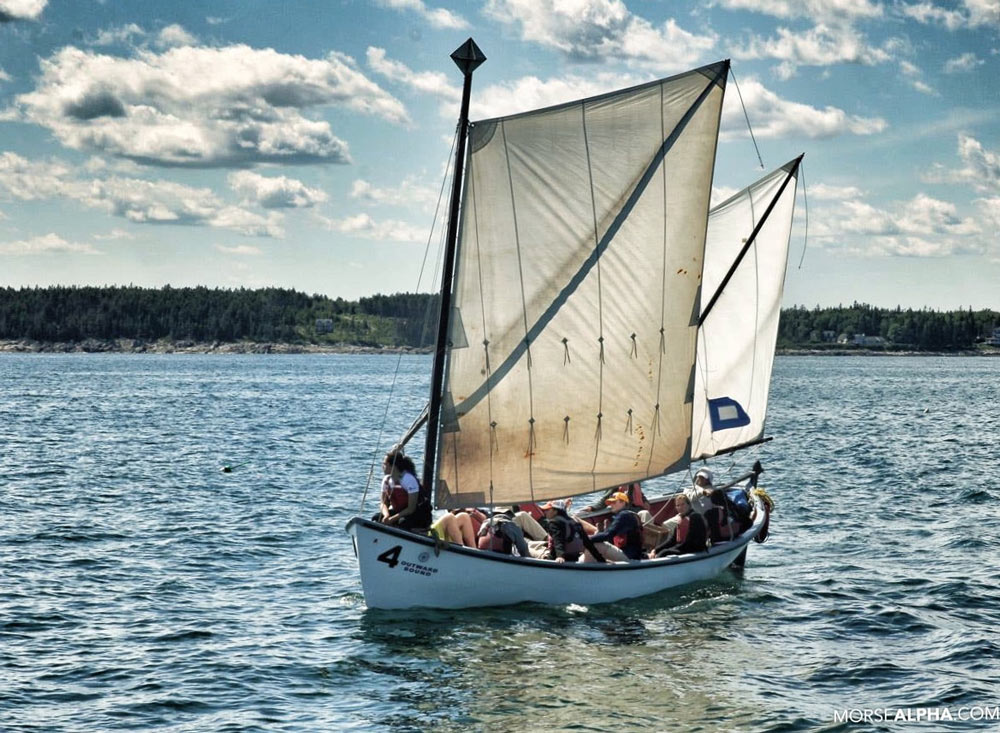
CHRIS:
So how have those various experiences translated to the business? It sounds like you teach traditional navigation. Is that a big part of what you do?
TERESA:
Yeah, I think that’s what makes our sail training program unique and special. We’re sailing on a modern yacht and we’re teaching people who are likely going to buy a yacht or already own one. But we have this philosophy that we bring to it from our days on traditional boats. The seamanship skills we teach are a blend of both the traditional and the new technology. We do a lot of traditional navigation. We teach our students how to navigate without any electronics from the very beginning. Usually, we don’t turn the chart plotter on until the very last day or maybe the second to last day. Because most of our students are going to have one aboard they need to learn how to use them as well because they’re a useful tool. But by the time we turn the plotter on, everybody feels very confident in their navigation skills. They can navigate just as well, if not better than using a chart plotter. And very often our students turn it on for a little bit to see how it compares and then they just go right back into navigating on their own. It’s pretty amazing. A lot of times these are the same people who are resistant to it on the first day. They say, “chart plotters great, why do we need to learn this?” And then they find a lot of joy in it and they also find that by doing it, they’re also learning other seamanship skills that really apply too.
BEN:
I think once you get past the hurdle and realize that it’s not very hard and that you can get a fix in just a few minutes…
TERESA
A few minutes? Less than that! I can get a fix in less than a minute. That’s why I do all the navigating!
BEN:
Uh, yeah. Once they realize how easy it is, they really embrace it.
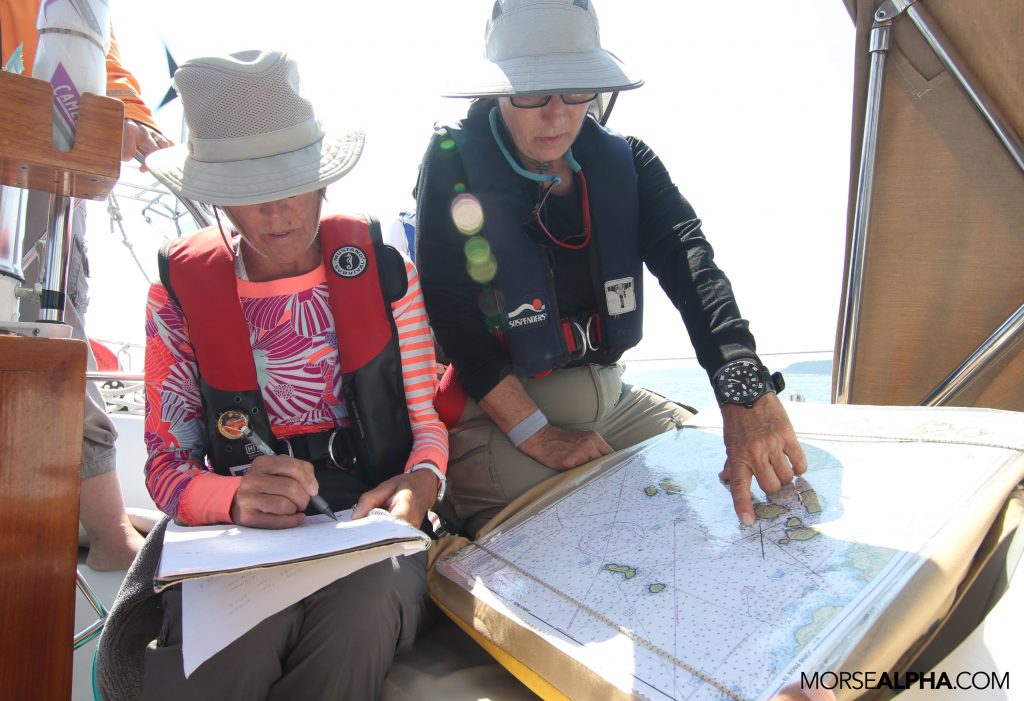
CHRIS:
So Teresa, do you have any navigation tricks for a quick fix? Do you use a sextant for altitudes or anything like that? You get crazy like that at all?
TERESA:
Oh, we don’t often use the sextant when we’re near shore because there’s enough things to navigate with, especially up in Maine, where a lot of our expeditions are based, there’s just a ton of things to navigate with like island and whatnot. So any tricks, well I have a zillion tricks, but you’re going to have to take one of my courses
BEN:
We do pull out the sextant on the offshore passages when we’re offshore for a few days where there’s nothing else to use for navigation.
CHRIS:
So Teresa, do you have any navigation tricks for a quick fix? Do you use a sextant for altitudes or anything like that? You get crazy like that at all
TERESA:
Oh, we don’t often use the sextant when we’re near shore because there’s enough things to navigate with, especially up in Maine, where a lot of our expeditions are based, there’s just a ton of things to navigate with like island and whatnot. So any tricks, well I have a zillion tricks, but you’re going to have to take one of my courses!
BEN:
We do pull out the sextant on the offshore passages when we’re offshore for a few days where there’s nothing else to use for navigation.
TERESA:
Ok, I have two tricks that you can incorporate right away if you’re navigating by compass and paper. When you’re taking three bearings for triangulating, in between each bearing that you take, you just leave your hand bearing compass in the horizontal position up to your eye because every time you drop it down, maybe to jot down a note or something like that, that compass card starts to spin again and it takes a moment to settle down and unspin. So if you put it down, and the card has to unspin every time, you end up having these long fixes, like Benji does. If you keep it up, you can do it in under a minute. I’m just kidding
BEN:
No, that’s a great one. Then all your fixes, I mean your bearings are within 30 seconds or so.
TERESA:
A few seconds, a few seconds! Each one is within a few seconds. One, two, three, just like that. The other trick is if you are just trying to do a little quick estimation of something, if you put your arms stretched out straight in front of you and your thumb and pinky fingers stretched out, like the hang loose sign, that’s about 15 degrees. It’s proportional, and it should be just about true for everybody. And so with a straight outstretched arm, your wingspan between your thumb and pinky is 15 degrees compared to your eye minus 15 degrees to my eye. So if you put your two hands together with your thumbs touching, that’s 30 degrees, and you can get some estimates of angles like that or the altitude of a star. It’s also a good way to be like, Oh, do you see that flashing light out there? No, I don’t. Well, it’s 15 degrees off something that we can both see. Any other person puts their hand out and they’re like, Oh yeah, I see it. Cool.
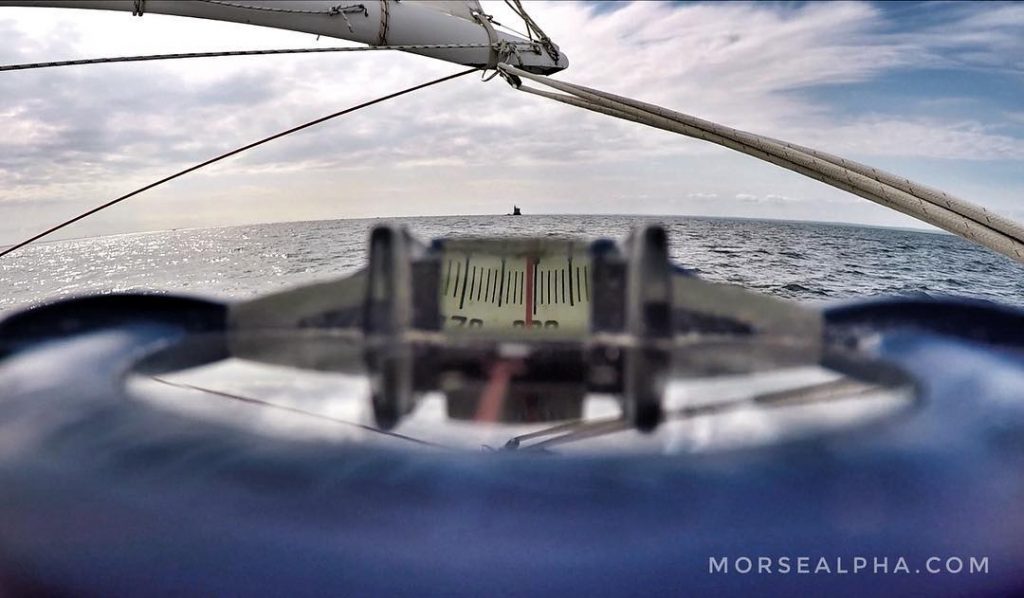
CHRIS:
So you guys have been teaching for quite some time. What have you learned through the process of teaching others?
TERESA:
We’ve been teaching a long time. I don’t want to say how long because I give away my age, but I started teaching when I was 18. Teaching sailing was my first job, and it has been nearly every year since then, so it’s been a long time. So, well, I learned to sail! I came into it knowing some, but not knowing much, not knowing the fine tuning of sails and things like that. But when you have to teach it, you have to know it really, really well to be able to just teach someone the basics.
BEN:
Yeah, on schooners we used to have a little saying that goes: see one, do one, teach one. Because often times your learning something new everyday. So you end up seeing how it’s done once, then you do it once, and then you’re right into teaching it to the next person. And that’s often, often how it worked on the schooners and tall ships. When we had new crew on board, you would just be thrown right into teaching. And that’s the best way to learn sometimes is by having to explain it to somebody.
TERESA:
That’s when you start to master it. The other thing that I learned about teaching is that, I hear a lot of people talking about yelling on board boats. People are often yelling at each other if things get a little crazy. I’ve heard from numerous people that their sailing partner is always yelling when the wind picks up. What I’ve learned is that’s a telltale sign of lack of confidence or not feeling in control. You never get anywhere when you’re yelling at somebody, you just don’t. So through teaching, we’ve learned to just be very slow and very calm about things. And it’s often surprising to people because our students will often feel a stressed when they’re Captain Of The Day and the challenge is to navigate and tack the boat through a tricky channel. But it’s a healthy stress! As instructors, we remain very calm because we know that the boat is safe and they can make mistakes and we’re still safe. I think that’s something that I’ve learned to do through time because of teaching.
CHRIS:
I see you’ve been working on new videos and I recently watched your Five Essential Sailing Knots on YouTube. What other kind of stuff have you been working on?
TERESA:
What’d you think of that video? Did you learn a new knot?
CHRIS:
I did! The Zeppelin Bend. Man, that’s pretty nifty. I didn’t know that one.
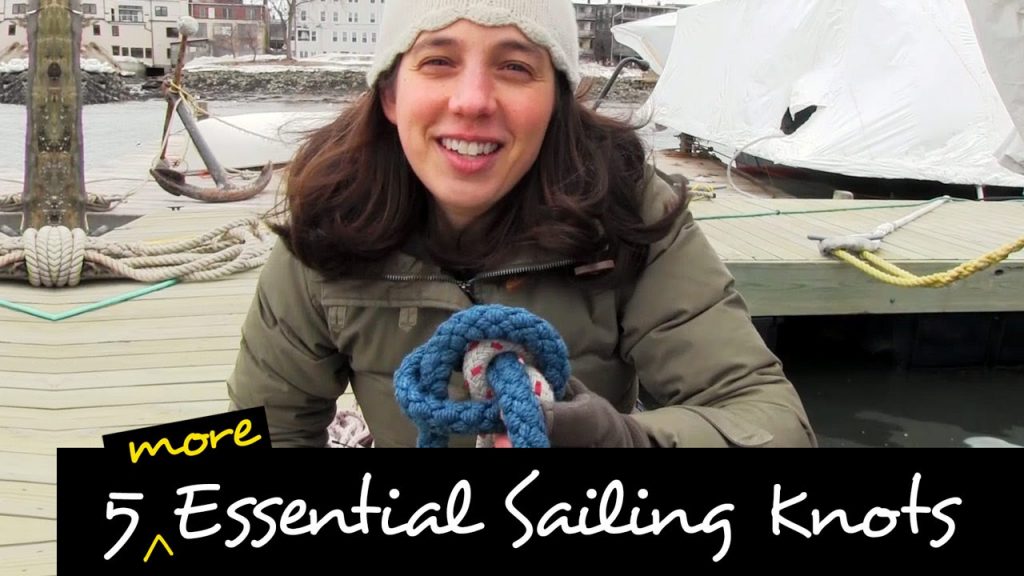
TERESA:
You know, that got me my first job as a captain. It was my first year working at Hurricane Island Outward Bound and I was working as a co-instructor. I don’t think they knew that I had a captain’s license. In fact, I’m pretty sure they didn’t realize that. One morning at basecamp, Wendy, the program director at the time comes running through the hallway yelling, Teresa, Teresa, and I’m like, I’m in here (the bathroom). She comes barging in and she says, Teresa, you have a license? And I said, yes. And she goes, what knot would you use if you needed to extend the anchor rode with another piece of line? And I said, I wouldn’t use a knot, I’d use a bend. And she said, which one? And I said, probably the Zeppelin Bend. She goes, you’re hired! You’re going out today as the captain!
CHRIS:
Yeah, that’s a good Zeppelin Bend story!
TERESA:
But we’re working on various forms of media. I think Benji and I took a break for a couple of years from sailing media and we’re trying to just get back into it and we’re trying to do, what we enjoy doing most. For a long time we did blogging, then we did some YouTube. I did a few radio pieces because I do science journalism now and I really liked that. So we might do some podcasting. We’re just trying to figure out our niche, and determine what needs we can fulfill.
BEN:
We started doing some live panel discussions. It was kind of complicated. So I think we’re going to tone it down to something a little more manageable, but still discussion-based. It’s called All Hands, and we’ll release it as a podcast. It’ll be topic-based discussions with two or three guests at a time.
CHRIS:
You have done a lot of sailing. You’ve trained a lot of sailors. You’ve done a lot of sailing on a lot of different kinds of boats. If you were looking for a modest family cruising boat, what would you be looking at now do you think?
BEN:
Hmm, I know Teresa’s answer. The Nor’sea 27. That’s a very modest family cruising boat!
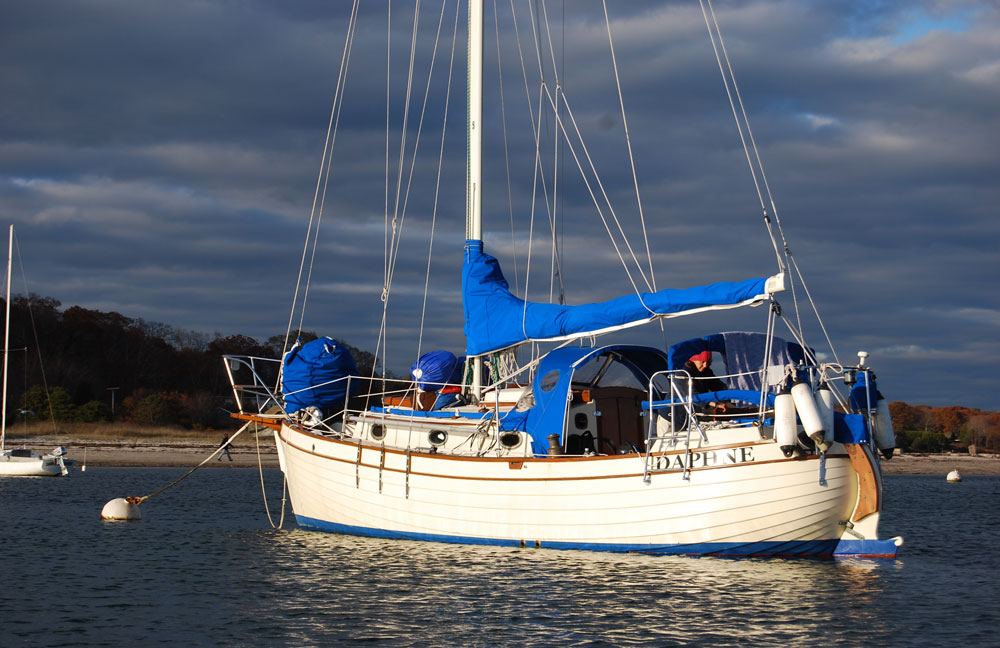
TERESA:
Yes, definitely. But think, how much time, when you’re sailing, do you spend cooped up inside a cabin if you’re really enjoying the life right? It should be outside of the cabin. But also, it’s just a really well designed boat. It’s very comfortable. Honestly, if we could have any boat, I’d really like to try the Nor’sea 37. It is the best combination of the Bristol Channel Cutter and the Nor’sea 27 as far as design goes. And we know, because we’ve owned bot. They both have their pros and cons. But the Nor’sea 37 looks to be a great combo of the best features from each. The problem is they’ve only built two hulls and I don’t think there’s ever been a completed boat. To my knowledge there is one that somebody is working on, but you just can’t get them used.
BEN:
They built three hulls. They lost two of them and there’s one that was being finished out in Southern California privately. But, I think he ran out of money. Nobody should count on us as the knowledgeable ones about what happened to those boats, that’s all we know. We’ve seen the design, the interior layout, and the line drawings and it’s pretty sweet.
TERESA:
Every boat, it’s a compromise. Now we know, after having sailed so many boats, what features we really like and what features we don’t like, what we want and what we don’t. You can never find a single boat that has all the things that you want. But I think the Nor’sea 37, based on the plans, comes pretty close for us at least.
CHRIS:
What kind of factors are you considering? Is it a whole form? How the rig is laid out? How the interior is laid out? What is your thought process there?
BEN:
Well, of course it’s all those things. The size is just about right. It’s a little longer but not too big. When we were searching for a boat for the two of us, we were looking in the high 30’s. Then at some point we decided to start Morse Alpha, so we went for a slightly larger boat. But if it was just the family, we’d definitely be in the 30s. We don’t need anything bigger than 39’. So the 37’ is a good size plus it’s got a wonderful layout. It’s got a center cockpit on a 37 foot boat, which is pretty unique.
TERESA:
The Nor’sea 27 has the best cockpit ever—it’s like a little nest. It’s very cozy. The nice thing about it is the aft cabin, sticks up and therefore makes a backrest for you to lean against. But Lyle Hess the designer was clever. Instead of making it vertical like most other boats, he inclined it just a little bit. So it’s the perfect angle for your back and you could sit there for hours, comfortably cruising along. It’s pretty amazing. Yeah, the 37 has that same cockpit with the aft cabin. It seems like it’s something so silly, but when you’re on passage you spend so much time in the cockpit sitting there, it’s important to be comfortable.
CHRIS:
Absolutely. So what are your personal sailing goals? Are you looking at doing some more cruising with the family here soon?
BEN:
Yeah, we definitely want to get Haven out for some cruising. We don’t know when exactly, but it’s on the table, the chart table.
TERESA:
He’s a little young right now. We don’t need to cruise right now. We’re talking about doing some overnights this summer in Maine with him. But as far as a big cruise with him, I think maybe when he’s a little bit older we’d like to take a sabbatical and just have a family adventure.
CHRIS:
Where do you think, where would you like to go if you have that opportunity?
BEN:
Well, I’ll tell you something. I’ve always dreamed of sailing over to Europe and do some exploring over there. Teresa wants to go back to the ice, little bit of Newfoundland, a little bit of Greenland. Well, in 2021, we’re going to go back to Newfoundland.
CHRIS:
Is that kind of like a guaranteed ice thing or does it depend on the year?
BEN:
Uh, up in Newfoundland for sure. That’s the definite thing. Now it’s just icebergs, not actual ice-ice. You have get up to Greenland for that.
CHRIS:
What about the places that you’ve been. Do you have a favorite place somewhere on the East coast of the US? It sounds like you spend a lot of time in Maine.
TERESA:
Well, Maine is our favorite place. We love Penobscot Bay and the whole coast of Maine with all the islands, but the further Down East you go, the better it gets. You could spend months in Maine and anchor in a different place every single night. And it’s beautiful every time. Sometimes there’s these lovely little fishing villages and sometimes it’s just a deserted Island. The other thing we love Maine is the variety. Every day is different. You can have sunshine one morning and a few hours later, it could be thick fog and drizzle and you could have wind or no wind. So it’s just an adventure all the time. Even though we’ve gone there year after year, we still discover something new every year.
CHRIS:
You guys are kind of in the business of giving people sailing advice, but is there a good piece of advice that you have received? And what kind of advice do you have for someone who’s getting ready to take their own boat off shore for the first time?
TERESA:
You know what, when you’re a woman, everybody wants to give you advice.
BEN:
When we used to sail the two boats in tandem, Daphne & Elizabeth, we’d pull into anchorages and people would be asking me some technical or engineering or gear question about our boat. They’d be talking to me assuming we were sailing on the same boat. And I’d say, well, I have this kind of blah-blah-blah on my boat, but ask Teresa, she’s got something totally different on her boat. I’d have to really go out of my way to bring her into the conversation as the boat owner, as the captain of her own boat.
TERESA:
And then the best part is, when they realized I was sailing my own boat solo, the next thing they’d say is, “Wow, and you’re not afraid?” But no one asked Benji if he was afraid, and he was alone on his boat just the same. But, that doesn’t answer your question at all. We’re on a tangent. What advice do we give other people? And what’s the best advice that we got? Well I’m not really sure what the best advice that I’ve gotten before.
BEN:
We always say that it’s really great to sail with a bunch of different people on a bunch of different boats before you actually purchase a boat if possible. You learn so much about what you need and what you don’t need as you when you do that. But, there’s a caveat about who you sail with.
TERESA:
I always tell them you can and you should ask for the skippers resume for their selling experience and for a recent survey of the boat so that you know that you’re going on a safe expedition. Anybody can own a boat, anybody can call themselves a skipper. You don’t have to have any experience or knowhow, there’s no nobody checking on the boat to make sure that it’s sound, there’s no official, annual inspection process for recreational boats like there is a minimum standard for a car. So I advise people to ask for a recent survey and a sailing resume. And really, any skipper who is safety conscious would have no problem providing that information in some form.
CHRIS:
That’s good advice. I crewed on a boat in the Caribbean 1500 a few years ago and they have pretty stringent safety inspections and gear requirements, which certainly as a crew member made me feel, better about the whole process.
BEN:
Yeah, definitely. We’re familiar with the Caribbean 1500. That was a good choice to crew on a boat there because it is vetted.
TERESA:
Although, I didn’t have a good experience with a rally. I was supposed to go on an offshore passage, and I’m going to keep it vague out of respect for everybody involved. I got aboard this boat and we’re getting the boat ready for a few days to go on this passage. The person who owned the boat was very adamant about being the captain. He’d often say, “I’m the captain, I have the final say”. For his first few passages, he hired someone to be the captain. But this one he didn’t. Now, I don’t mind being not the captain. I’ve been captain plenty of times and so I was just happy to do whatever he needed me to do; stand watch, cook, and things like that. It’d be fun. But as we continued preparing for the trip, I started to feel very nervous about it. I started to notice, streaks of water in some lockers down below. I asked if we could trace where this water’s coming from. But the response I got was, “Oh, it’s going to be fine. Don’t worry about it”. He just dismissed my concerns and said “Trust me, it’s fine”. I also didn’t think we had enough vegetables on board. Most certainly we had enough food, we weren’t going to die or anything. But you want everybody to be healthy and regular. It’s important! If you want a great experience, not just to get there, you want to get there with joy. So, I said we need more vegetables. And again he said, “no, no, it’s going to be fine”. So this was going on like that for a few days, and I eventually just felt drained and nervous, and a little off-put that my concerns weren’t being addressed or even answered. At the time, I couldn’t articulate how I was feeling. All I could conclude was that this just doesn’t feel right. After a few days, I decided not to do the trip. I’m really glad that I didn’t because it was a big lesson for me to learn that even though I wasn’t the captain, that I wasn’t in charge, that I was trying to be respectful and accepting what he said, that there’s a fine line there. A real leader would never just let it go on like that when there’s a real concern. A good leader would have listened to my concerns and responded in such a way as to alleviate those concerns or address those concerns or fix whatever the problem is, if there actually is one. So it was a good lesson in leadership for me when I was trying not to be the leader. I could have articulated my concerns a little better. I could have tried to bring the group together in a different way—as just a crew member. So ultimately they couldn’t do the passage either. Almost 24 hours after setting out, they ended up turning around because there was water above the floorboards! They had a major leak, and it turned out the mast partners needed some reconstruction. So that’s a good example of what not to do in terms of leadership!
CHRIS:
So what makes a good leader?
TERESA:
I think a good leader doesn’t ever yell, hands down. A good leader is someone who can facilitate a group and help everybody feel like they had an important contribution, feel like they were a part of it and that they got there with some sort of joy and togetherness. On our trips, we have people with all sorts of different experience levels. Some of them are very skilled and used to being a leader or running their own boat. And we also have people that are used to just taking orders, or sitting back, or have never been sailing. So we make sure that everybody has a voice and that everybody’s respectful of the other person’s voice. We’ve set up a structure so that we don’t have to tell people, “Be respectful, you’re not being respectful!”. Instead, we’ve created a structure that facilitates everybody coming together as a team. Everyone listens to each other, supports each other, learns from each other, or teaches each other things. Even if they didn’t know that they were capable of doing all of that. It’s pretty amazing to see the growth. One person might say, “Oh, I can’t be Captain Of The Day”. But then they make an amazing Captain Of The Day and it happens every time.
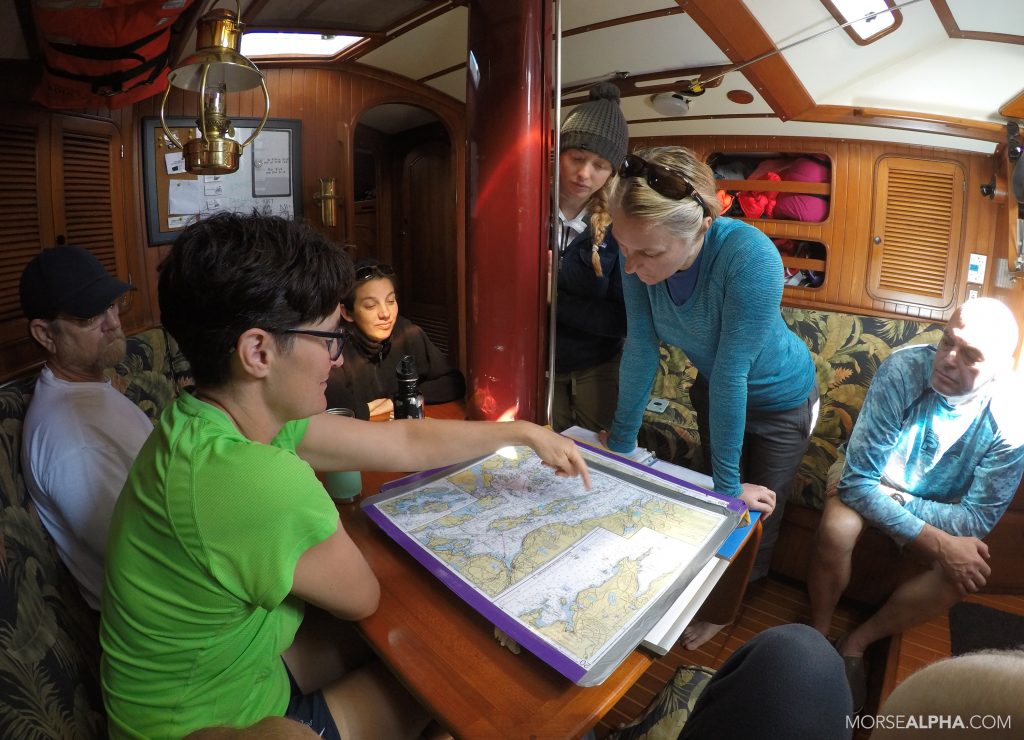
BEN:
It’s super rewarding for us as instructors to see that happen. It’s not because of us per se, it’s just because people step up into the leadership role and they do it because they have to, and sometimes it’s just because they’re finally given the opportunity to be in that role, and they’re naturals.
TERESA:
It’s also not just stepping up into a captain role or a role that they’re maybe nervous about doing. For some people it’s steering the boat, or navigating and having the responsibility of being the navigator, or for some it’s cooking. For some people it’s challenging to step back when they’re used to being in control. And so it’s pretty amazing to see people work together in different ways than they’re used to.
BEN:
Sometimes people call our program couples therapy on the water. There’s a really great article in Wooden Boat Magazine called Lessons of the Bounty: Drawing Experience From Tragedy, by Andy Chase, that we like to reference. It kind of deconstructs The Bounty sinking. He talks about how the captain needs to use all his personnel as resources and get assessments from each one about the condition of the vessel in their department and the condition of their team. And just how important it is to not be a captain who holds all the cards in his hand hidden from the rest of the crew.
TERESA:
There’s this historic notion that the captain is the one in charge and the captain makes all the decisions. But I actually think that captain who feels that way about their job is a little bit foolish because no one, no single person knows everything about everything and every situation, and is always healthy or fit or alert enough to make all those decisions, all the time. That’s a tall order! More importantly, I think a good captain would recognize the resources they have, which includes the people they have aboard. And so to bring them together in a way that uses everybody’s best strengths makes a good leader.
CHRIS:
Well, it’s time wrap this up guys. One last question. Where are you headed with the business next, what kind of projects you have in the works, and where people can find you online.
TERESA:
Well the business sort of took a little break last year — we only did four trips. We had Haven, he was brand new and the year before we did the same thing while I was pregnant. So it feels like we’ve had a couple of just real light years.
BEN:
And then the year before we had to replace our engine. So we’ve had three really light years. So I feel like we’re just ramping up again and getting things going. In 2020, we’ve got 10 trips on the schedule. We’re heading back to Maine. We’re going to make a run out to Halifax and a couple of other nice offshore trips up the coast. And in 2021 we’re talking about doing the Marion to Bermuda Race, and also getting the boat up to Newfoundland and possibly doing a circumnavigation of Newfoundland. So that’s kind of where we’re heading with the business. A little more offshore stuff, but still keeping it a mixture of offshore and coastal because we always believe that the real challenges are where the at the coast where land and water meet. That’s where you have to be on your game 24/7. That’s really where we like to teach.
TERESA:
And that’s also where most cruisers spend the majority of their time. You may do a passage, and I know the open ocean is a big mystery, and people want to experience that mystery for the first time under the guidance of someone who has experience doing it. And that’s important. But also there’s just so many skills that can be learned at the coast. A lot of time, we’ll get people aboard board who say that they’re advanced sailors, they just want the offshore part, but then they’re really struck by how much they learn in the coastal training that we do. We always have a coastal component on every one of our expeditions and that helps us provide a really robust program.
BEN:
Everyone’s pretty sleepy by about eight o’clock—and then we make the cookies! But that’s where we’re headed—some bigger offshore passages, but still maintaining a strong coastal component. And to wrap it up, people can find us online at morsealpha.com. Thanks for having us!
EMAIL: thebonnieboat@gmail.com
WEBSITE: thebonnieboat.wordpress.com

